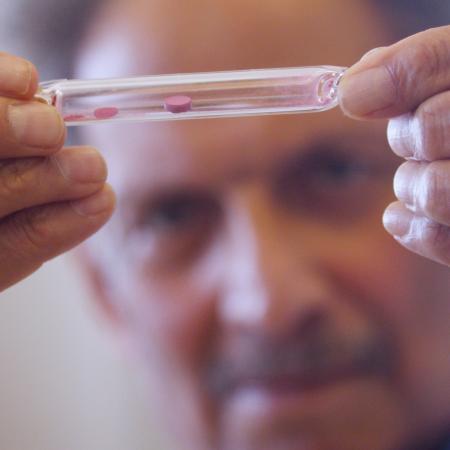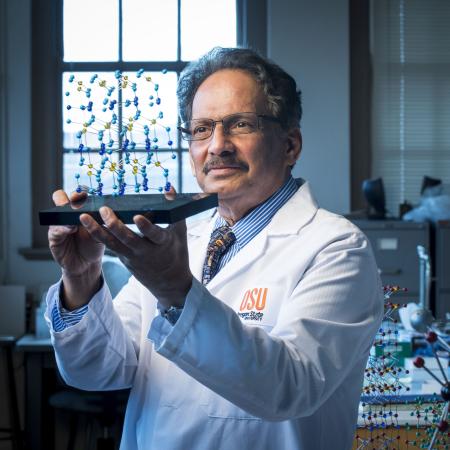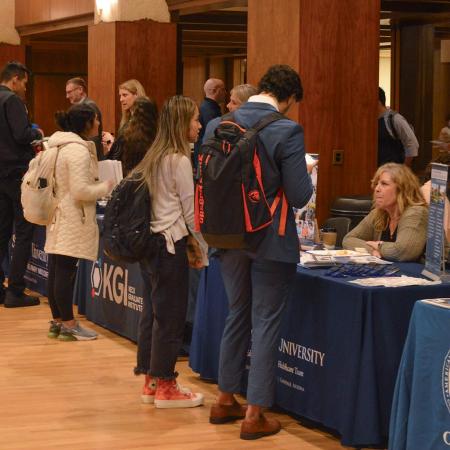Milton Harris Chair Professor of Materials in Chemistry Mas Subramanian will soon embark on highly significant scientific research and discovery after winning two prestigious highly competitive National Science Foundation (NSF) grants. Subramanian and his research team were awarded a three-year $470,000 NSF grant for their project, “Exploratory Chemistry of Oxide-Based Compounds.” Subramanian also received a collaborative DMREF (Designing Materials to Revolutionize and Engineer our Future) three-year grant for $299,993, which is part of the $1.5 million funding from NSF involving five institutions.
This award will support their research on “Discovering Insulating Topological Insulators,” which potentially will lead to room-temperature superconductors and other advanced semiconducting electronic materials that could revolutionize the computing, energy and electronics industries. Topological insulators are a new class of materials likely to surpass silicon in terms of performance in electronic circuits and computing technology. Subramanian’s goal for his second project is to discover new topological insulator materials pure enough to incorporate into electronic devices and circuits.
Subramanian is the principal investigator on both research proposals.
"We are proud of the outstanding research coming out of Mas' lab, and delighted that it is being recognized by NSF through its grant funding. Mas is an excellent mentor for a diverse set of students, and this funding will help us advance our strategic goals to build on our areas of distinction and to increase our commitment to student success," said Sastry G. Pantula, dean of the College of Science.
Subramanian is no stranger to groundbreaking scientific innovations and discoveries in the field of functional materials chemistry. He is perhaps best known for his astonishing discovery of a new durable, environmentally friendly blue pigment in 2009—the first of its kind since the creation of cobalt blue in the early 1800s. His team’s creation of what has been called “the world’s best blue pigment” from a trigonal byramidal crystalline structure of atoms has led to the manufacture of other non-toxic color pigments.
Subramanian’s project on oxide-based compounds will focus on the discovery and understanding of their crystal structures, chemical bonding and physical properties to design new functional materials in the areas of energy, environment and electronics. Subramanian will also expand upon his discovery of the blue pigment by using the new metal oxides to create a range of yellow, orange and red non-toxic and durable inorganic pigments. The research will lead to new energy saving, room-temperature superconducting oxides and industrial materials.
“I am extremely excited to receive these NSF grants as they provide opportunities for us to explore new scientific frontiers in materials chemistry and to train students in an area that is critical to national and global economic growth and security,” said Subramanian regarding winning these grants.
Subramanian, who currently advises and mentors doctoral students and postdoctoral associates, will be using his NSF-funded research projects to equip graduate students within the skills required for the discovery and formation of new materials and provide them with an understanding of the complex crystal structure and their properties. This training will prepare students well for careers in industry and academia. In addition, the oxide based compounds research will expose undergraduate and high school students to hands-on research experience and careers in science and technology.
After spending much of his career as a research scientist at DuPont in R&D,Subramanian joined the Department of Chemistry in 2006. The majority of his research here has focused on discovering new materials and processes that impact energy, electronics and the environment. Subramanian and his team have been involved in highly impactful and pioneering research on new, energy-saving materials, materials that capture waste heat and convert it to electricity, as well as new, durable paint pigments that can be used to conserve energy by reflecting heat from solar radiation.
Discovery of new blue pigment hits the commercial market
The brilliant blue pigment discovered serendipitously by chemist Mas Subramanian in 2009 will arrive in the marketplace later this year in the form of coatings and plastics.
Subramanian and his team were experimenting with new materials to use in electronics applications when one sample turned out to be a vivid blue. This new durable pigment was the first in more than 200 years.
OSU has reached an exclusive licensing agreement with The Shepherd Color Company for the pigment, known as “YInMn” blue. The pigment is formed by a unique crystal structure that allows the manganese ions to absorb red and green wavelengths of light, while only reflecting blue. The vibrant blue is so durable, and its compounds are so stable, that it does not fade.
These characteristics make the new pigment versatile for a wide range of commercial products. And best of all, none of the pigment’s ingredients are toxic.



